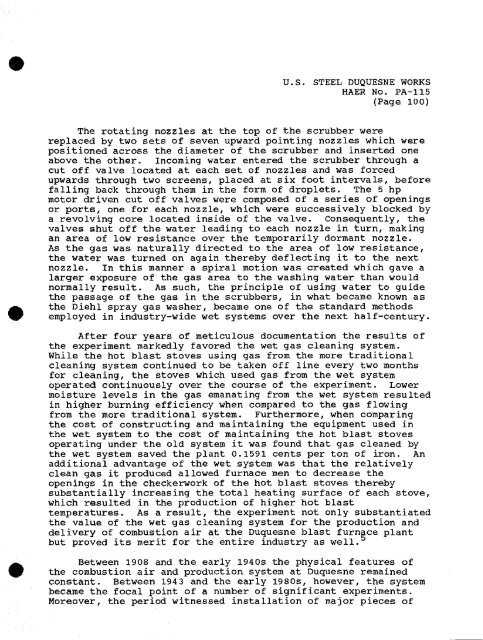pa1778data.pdf
pa1778data.pdf
pa1778data.pdf
Create successful ePaper yourself
Turn your PDF publications into a flip-book with our unique Google optimized e-Paper software.
#<br />
»<br />
U.S. STEEL DUQUESNE WORKS<br />
HAER No. PA-115<br />
(Page 100)<br />
The rotating nozzles at the top of the scrubber were<br />
replaced by two sets of seven upward pointing nozzles which were<br />
positioned across the diameter of the scrubber and inserted one<br />
above the other. Incoming water entered the scrubber through a<br />
cut off valve located at each set of nozzles and was forced<br />
upwards through two screens, placed at six foot intervals, before<br />
falling back through them in the form of droplets. The 5 hp<br />
motor driven cut off valves were composed of a series of openings<br />
or ports, one for each nozzle, which were successively blocked by<br />
a revolving core located inside of the valve. Consequently, the<br />
valves shut off the water leading to each nozzle in turn, making<br />
an area of low resistance over the temporarily dormant nozzle.<br />
As the gas was naturally directed to the area of low resistance,<br />
the water was turned on again thereby deflecting it to the next<br />
nozzle. In this manner a spiral motion was created which gave a<br />
larger exposure of the gas area to the washing water than would<br />
normally result. As such, the principle of using water to guide<br />
the passage of the gas in the scrubbers, in what became known as<br />
the Diehl spray gas washer, became one of the standard methods<br />
employed in industry-wide wet systems over the next half-century.<br />
After four years of meticulous documentation the results of<br />
the experiment markedly favored the wet gas cleaning system.<br />
While the hot blast stoves using gas from the more traditional<br />
cleaning system continued to be taken off line every two months<br />
for cleaning, the stoves which used gas from the wet system<br />
operated continuously over the course of the experiment. Lower<br />
moisture levels in the gas emanating from the wet system resulted<br />
in higher burning efficiency when compared to the gas flowing<br />
from the more traditional system. Furthermore, when comparing<br />
the cost of constructing and maintaining the equipment used in<br />
the wet system to the cost of maintaining the hot blast stoves<br />
operating under the old system it was found that gas cleaned by<br />
the wet system saved the plant 0.1591 cents per ton of iron. An<br />
additional advantage of the wet system was that the relatively<br />
clean gas it produced allowed furnace men to decrease the<br />
openings in the checkerwork of the hot blast stoves thereby<br />
substantially increasing the total heating surface of each stove,<br />
which resulted in the production of higher hot blast<br />
temperatures. As a result, the experiment not only substantiated<br />
the value of the wet gas cleaning system for the production and<br />
delivery of combustion air at the Duquesne blast furnace plant<br />
but proved its merit for the entire industry as well.<br />
Between 1908 and the early 1940s the physical features of<br />
the combustion air and production system at Duquesne remained<br />
constant. Between 1943 and the early 1980s, however, the system<br />
became the focal point of a number of significant experiments.<br />
Moreover, the period witnessed installation of major pieces of

















